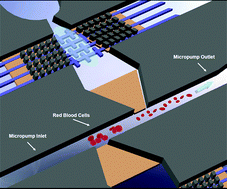An air-bubble-actuated micropump for on-chip blood transportation†
Abstract
A novel electrolysis-based micropump using air bubbles to achieve indirect actuation is proposed and demonstrated. Compared with other electrochemical micropumps, our micropump can drive microfluids without inducing the pH value variation in the main channel and the choking/sticking phenomena of electrolytic bubbles. It is promising for biomedical applications, especially for blood transportation. Our proposed on-chip electrolysis-bubble actuator with the features of room temperature operation, low driving voltage, low power consumption and large actuation force not only can minimize the possibility of cell-damage but also may enable portable and implantable lab-on-a-chip microsystems. Utilizing our proposed hydrophobic trapeziform pattern located at the junction of the T-shaped microchannel, the micropump makes the pumped fluid in the main channel be isolated from the electrolytic bubbles. It can be used for a variety of applications without the constraints on the pumped liquid. Experimental results show that the liquid displacement and the pumping rate could be easily and accurately controlled via the signal of a two-phase peristaltic sequence and the periodic generation of electrolytic bubbles. With an applied voltage of 2.5 V, the maximum pumping rate for DI


 Please wait while we load your content...
Please wait while we load your content...